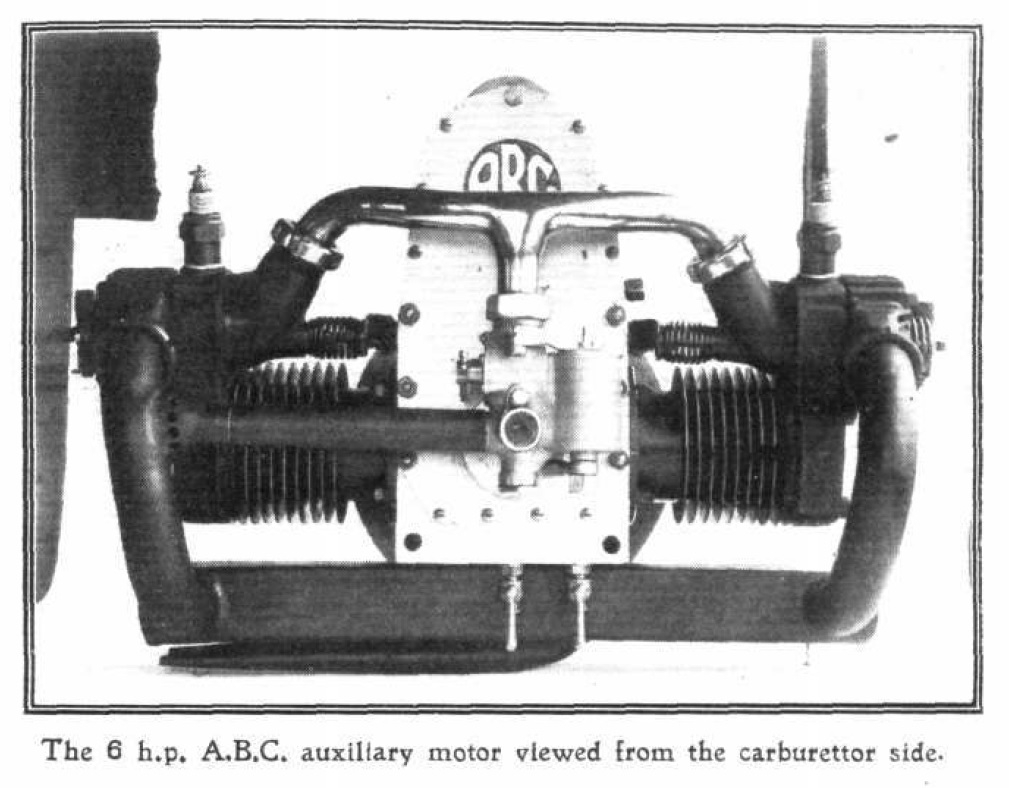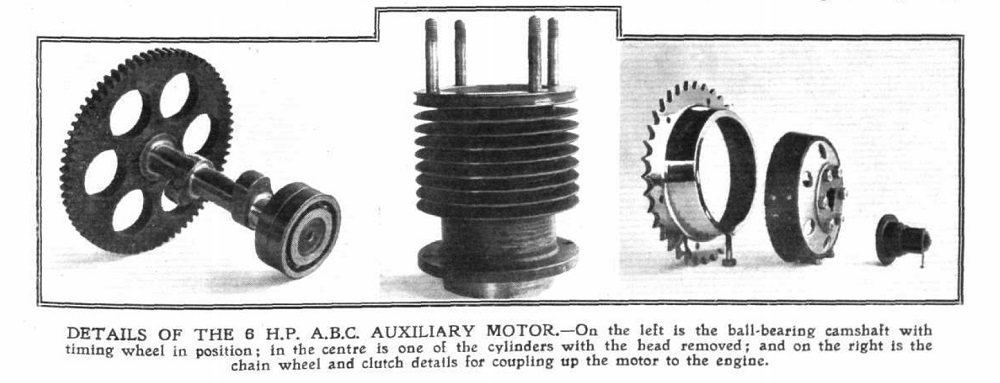A 6 H.P. petrol engine for engine starting, and for driving lighting, wireless or blowing sets.
With the gradual tendency exhibited in modern practice towards the development of larger and more powerful aeroplanes, especially those of the seaplane type, the desirability of providing some mechanical device which will enable the pilot to start the engine, without outside assistance, becomes increasingly evident.
Coupled also with this is the fact that the use of wireless apparatus is becoming more extensive on military machines; and where any night operations are contemplated, the utility of a lighting set for the purpose of signalling to or illuminating the ground upon which the pilot may desire to land, will be readily appreciated.
Weight and space are, however, important factors where the aeroplane is concerned, and with the object of producing an engine that would occupy the minimum of space, involve the smallest possible increase in weight, and be able to either turn the engine or drive the dynamo, according to the requirements of the moment, the A.B.C. Road Motors, Ltd.. of Hersham, Walton-on-Thames, and their chief engineer (Mr. Granville E. Bradshaw) have applied the results of their extended experience in aeronautical and high speed engine design upon the design of their new auxiliary motor.

The engine, which is of the two-cylinder opposed type, is air-cooled, and develops its rated horse-power (6 h.p.) at 3,300 revolutions per minute, which corresponds to a torque of 115 lb. ins. The arrangement of the cylinders and cranks employed is such as to tend naturally to reduce vibration to the minimum; and the claim is made, that it is possible to hold the engine in the hand when it is running at a speed of 4,000 revs. per minute. The cylinders are of steel, machined from the solid bar; but the heads, which are detachable, as may be seen from one of our photographs, are of cast iron - as are also the pistons - and are held in position by four steel studs. To ensure an entire absence of gas leakage at the joint between the head and the cylinder body, ample width has been provided for the jointing surface. All bearings throughout the engine, with the exception of that at the small end of the connecting rad, are of either the ball or the roller type, and lubricating oil is supplied through adjustable drip feeds from an oil tank placed immediately over me engine. Provision is made for determining the level of oil in the crank-case by fitting two cocks in the lower portion, the upper of which gives the correct level of oil. The crank-shaft is a one piece forging of high tensile steel, as is also the single cam-shaft which operates the inlet and exhaust-valves in both cylinders, through the four hanging tappet levers, by two cants, thus giving perfect synchronisation and even running. The exhaust-valves are located in the cylinder-heads, and with the inlet-valves are so designed that, in the remote event of the valves breaking, the heads will not fall into the cylinder.

The engine is supplied completely equipped ready for running, except for the connection to the petrol tank ; and the weight of 59 lbs. includes the magneto, Claudel Hobson carburettor, induction and exhaust pipes, flywheel, starting lever, flexible coupling and all wires and connections. Where it is intended to use the engine in connection with a wireless set or for driving blowers for the ballonets of airships, a speed governor driven from the magneto shaft is also fitted; and if special importance is attributed to lightness, the weight quoted above can be reduced by a few pounds. This motor may be started from the pilot's seat, as the geared-up ratchet lever provided can be carried thereto by an extension rod, wherever the engine may be located, and without appreciably increasing the weight of the set.
The clutch is mounted upon the extremity of the crankshaft remote from the starting end, and consists, as will be seen from one of our photographs, of a female member upon which the sprocket for driving the main engine is mounted, and a male conical sliding member faced on its periphery with a special clutch lining. Normally, the male portion is held out of engagement with the outside member by a spring — exactly the opposite action to that which is arranged for in the ordinary car clutch. When it is desired to start up the main engine, the pilot starts up the auxiliary motor by pulling the ratchet lever, gradually opens the throttle, and pushes in the clutch. As soon as the main engine commences to run under its own power, the clutch lever is released and the clutch disengages under spring action. It is stated that this auxiliary motor will start up an average engine of about 230 h.p. from cold, with ease, and will keep it running at about 300 revs. per min. for so long as petrol and oil are fed to it. The engine is supplied with or without the main engine starting equipment ; but the latter can be added without difficultly, and the attachment to the main engine by chain can be readily effected.
In designing the unit, every endeavour has been made to simplify the construction as much as possible, and to eliminate all parts that could be dispensed with, without impairing any of its desirable qualities, and the result appears to be in every way satisfactory. The importance of ready access to such parts as are most likely to receive attention was also borne in mind, and a large end door on the crankcase renders inspection of the whole of the interior a matter of only a few minutes'work. Obviously the application of the power unit is not limited to the particular uses we have specified. Although its lightness, combined with strength and reliability render it specially adapted for use on aeroplanes and airships, these same qualities are also eminently desirable where transport difficulties are encountered, and, therefore, it should find ready acceptance for portable field wireless and lighting sets.
From "Flight" - March 12th, 1915
